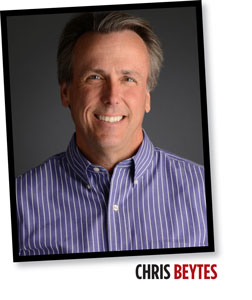8/1/2022
Remembering Andrew
Chris Beytes

Thirty years ago this month, Hurricane Andrew struck South Florida. I was a few hours north of Miami in Brevard County, and my wife and I were keeping a close eye on the powerful Category 5 storm. Up until 12 hours before Andrew made landfall there was uncertainty about where the storm would strike. Would he hold course or dip south and hit the Keys? Veer north and destroy Miami? Or turn hard north and come up the coast to wipe out my 1-acre greenhouse operation?
Andrew didn’t waver—he plowed straight west over Homestead, where, in just a few hours, sustained winds of 165 mph destroyed 63,500 houses, damaged 124,000 others, caused $27.3 billion in damage and killed 65 people.
And wiped out Homestead’s horticulture industry.
Up in Merritt Island I breathed a sigh of relief, but I felt for my brethren in Homestead. I couldn’t imagine what they were going through.
Mike Rimland didn’t have to imagine it—he lived it. Today Mike is VP of R&D for Costa Farms; back then he was running Rimland’s Nursery in Homestead. I called Mike to reminisce about Andrew.
“One thing I remember about this hurricane is that we kept saying, ‘I don’t know, it’s not that windy,’” he told me. “We were standing outside and it wasn’t that windy. And then it started to get a little windier, like 30 to 40 miles per hour, and we said, ‘Yeah, we’d better go inside.’ But once inside we were saying, ‘I don’t know, this thing doesn’t seem like it’s a big deal.’”
August 24—Sunday night—Andrew made landfall.
“I swear to God, Chris, from one minute to the next, I have never in my life imagined anything like it before or after,” Mike recalled. “The thing roared like you just could not even imagine. I mean, to the point where I probably just mentally blocked out a lot of what happened. Roared! Roared, like I can’t even describe it. And it roared for like an hour and a half … the whole house blown apart, a corner of the roof ripped off and you’re literally hiding under a mattress wondering what the hell is going on.”
The next morning, Mike drove to his nursery. Normally, it would take four minutes. That day it took 45. Andrew had destroyed 1,300 acres of shadehouses and greenhouses and more than 4,000 acres of woody ornamental nursery crops. Total losses were estimated at $206 million, including $120 million in plant inventory.
“Literally, the nursery was disintegrated,” Mike recalls. “There were no plants or pots anywhere. A million square feet was gone.” An illustration of the power of the storm: “We had one of those 40-yard construction dumpsters. Gone. It blew away.”
Two months later, in October, I got to see the damage for myself when Jim Batts of Nursery Manager magazine gave me my first serious freelance assignment: write about what was being done to rebuild the Homestead industry.
Gulp. Scary! But I said yes and arranged to stay with a friend in Miami so I could roam Homestead for a few days looking for stories.
What I found was both a war zone and an industry on the rebound. As I described it in Nursery Manager, “Nearly every facility, large and small, though still showing evidence of the storm’s destructive force, also shows evidence of the resilience of the people of the nursery industry and their desire to get things back to normal. New shadehouses and greenhouses sprout from the wreckage of old. Neat rows of plants, showing new flushes of growth, provide contrast to the mountains of dead plants, mangled metal, broken PVC and torn shadecloth that line the road.”
One might think Andrew changed Homestead’s nursery industry by enabling the big to get bigger at the cost of small businesses who couldn’t afford to rebuild. That’s not the case, Mike says. In fact, a University of Florida study done in 1993 reported that about 85% of the nursery businesses rebuilt. And by 1993, Dade County’s nursery production was at an all-time high. The major consolidation in the foliage industry came later, driven primarily by the mass market.
Today, 30 years later, I’d wager that every business in Homestead that survived Andrew—and other hurricanes that have crossed South Florida since then, including Katrina (2005), Wilma (2005) and Irma (2017)—have developed a sense of preparedness, toughness and resilience that only comes from surviving a major disaster. Not that I’d wish it on anyone—but it prepares you to face any challenge that comes your way without wavering … and isn’t that the definition of our industry? GT